Occasionally we come across haikyo that are shocking not due to an unsettling atmosphere or dilapidated state of grandeur, but because of the historical significance of objects left behind. Pieces that might better belong in a museum that have long been forgotten and stolen glimpses into the lives of past inhabitants that should have gone unseen.
On Respecting the Past
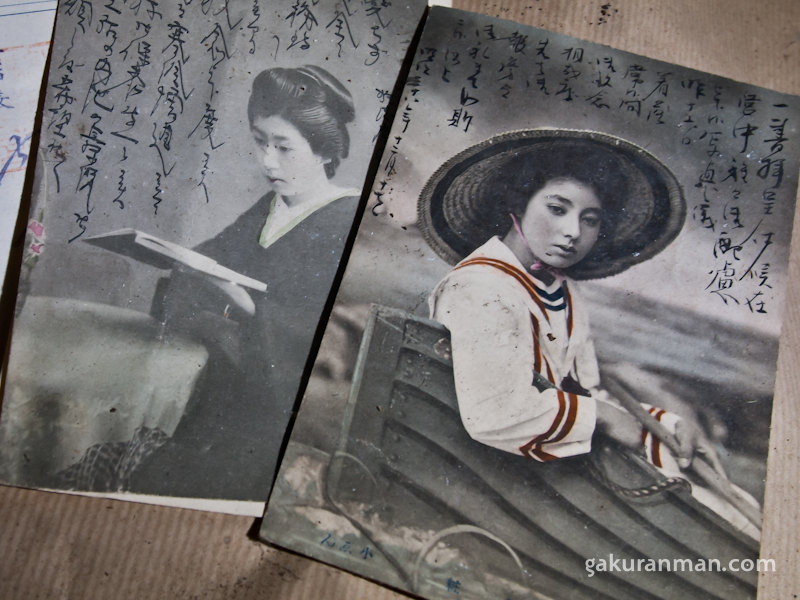
It’s something of an ethical dilemma. How can one salvage memories of the past and simultaneously respect the privacy of residents long since gone? Photographs, clothes, keepsakes and personal trinkets litter all manner of ruined buildings, each with a fascinating story to tell and historical insight attached. But while tip-toeing through the ghosts of the past, one cannot but help feel guilty of invasion; a ghastly set of eyes piercing would-be explorers with a burning sense of immorality.
Is this right? Should I be here? …Why am I here?

Some such thoughts were creeping their way through my mind as I treaded carefully on the broken floorboards of the ground floor. It looked to me like they had collapsed due to weakness rather than vandalism, and the resulting mess of furniture was unfortunate. But upstairs was a different story. I clicked on my headlamp inside a second floor room of my latest haikyo exploration. The Royal House, as it’s known on the Japanese internet. A plethora of goodies. A burglar’s paradise. A historian’s fancy.
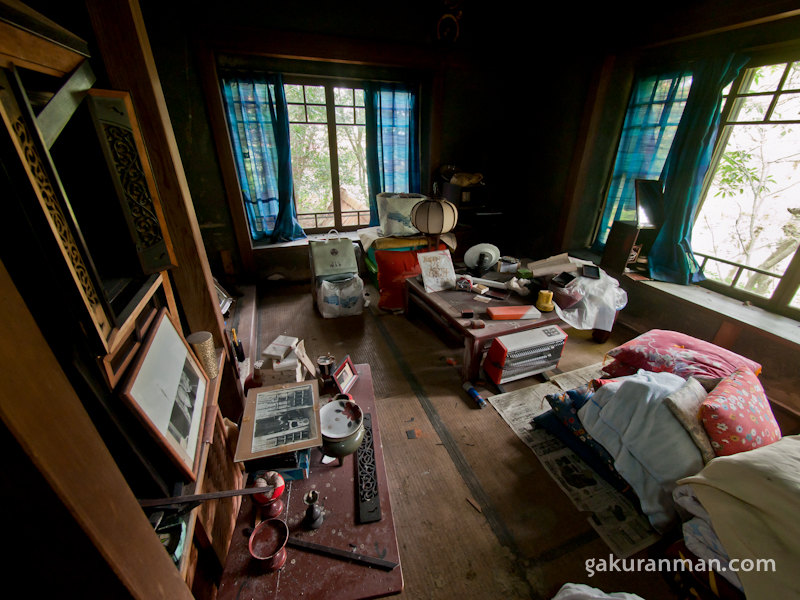
The place was still rather neat. A fine layer of dust covered everything around me and the now familiar smell of mould found in old spaces filled the air. Faint beams of light filtered through a small hole in the roof made by a fallen tree and the surrounding silence was only broken by my own shallow breathing. I could reach out and touch piles of boxes to both my left and right and directly in front of me was a neat pile of bedding and clothes. Along the walls, various pieces of classy wooden furniture adorned with exquisite Japanese dolls and drawers stuffed with yellowed letters, postcards and household items. At the end, a closet half open containing a row of pungent men’s suits.
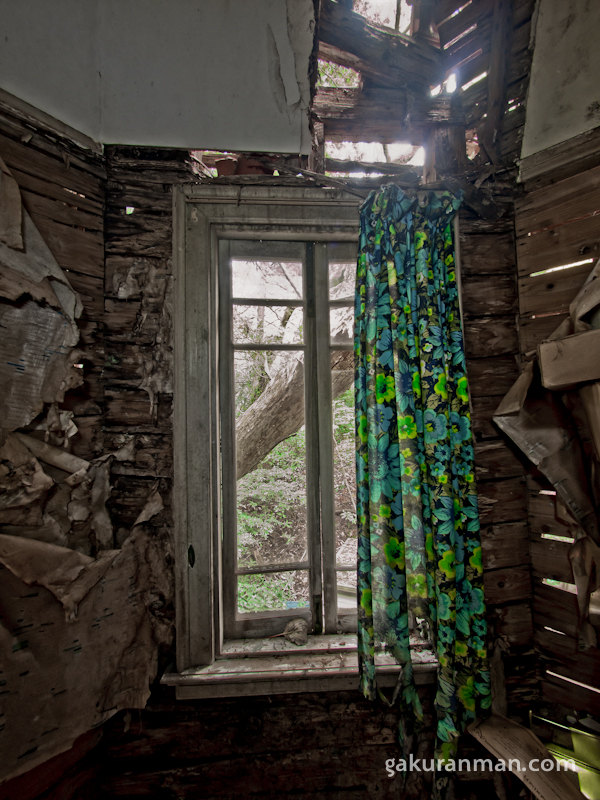
It’s unusual to find a ruined house in as good a state as this one was. Most of the time either nature has demolished such buildings or they have been ransacked and left in disarray by disrespectful visitors. It seems the Royal House haikyo is largely unknown on the internet, as I couldn’t find any definitive hints about the location or signs of vandalism.
A House Worthy of the Name
Placing my tripod down upon the soft tatami mats, I stared in awe at the sight before me. A collection of large portrait pictures, all neatly framed and standing in an alcove next to the Buddhist altar. I wondered just what to make of it.
This place is…too much. Can I even write about this house? Unwanted attention would be the end of it.
I knew I had seen one of the pictures before somewhere before, and understood instantly what the surrounding pictures all had in common. A familiar symbol caught my eye, glinting gold. It was the mark of the Imperial House of Japan.
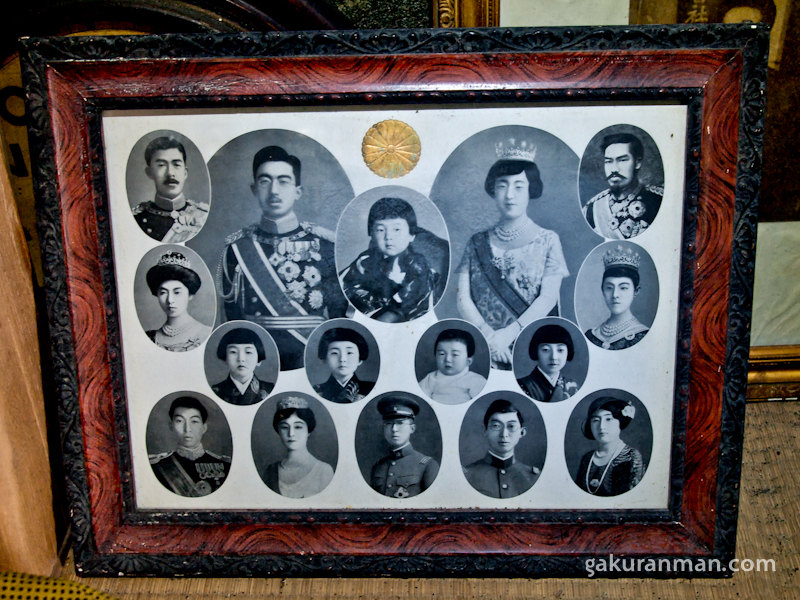
Pictures of the Japanese Emperor and the Royal family. The surrounding portraits also showed large photographs of various members, most of whom I couldn’t put an immediate name to, but having come home and researched, it confirms that and a lot more. The picture above is no ordinary picture. I thought as much judging from the embossed logo placed top centre.
The picture is none other than the Imperial Family Portrait. To give you an idea of just how significant this is, let me talk a bit about the historical background.
The Imperial Family Portrait is known as 御真影 (ごしんえい) and was issued on loan by the Imperial Household Ministry to various select schools and other houses before World War II. (Maruyama University)
ごしんえい=戦前、宮内省から各学校に貸与された、天皇・皇后の写真。各家庭でも飾られた。
In pre-WWII Japan, the Emperor was still revered as a living deity and to look upon him was thought of as an immense privilege. Distribution of the Imperial Family Portraits was not compulsory and schools had to petition to the Ministry in order to receive one, which was usually granted on grounds of academic excellence. Because the official portraits were on loan from the Imperial Household Ministry, protecting the picture from harm was deemed of utmost importance. Having the picture lost or damaged, even from natural disasters like fires or earthquakes, was seen as such a serious failure of duty that there were incidents of school officials committing suicide in an act of repentance.
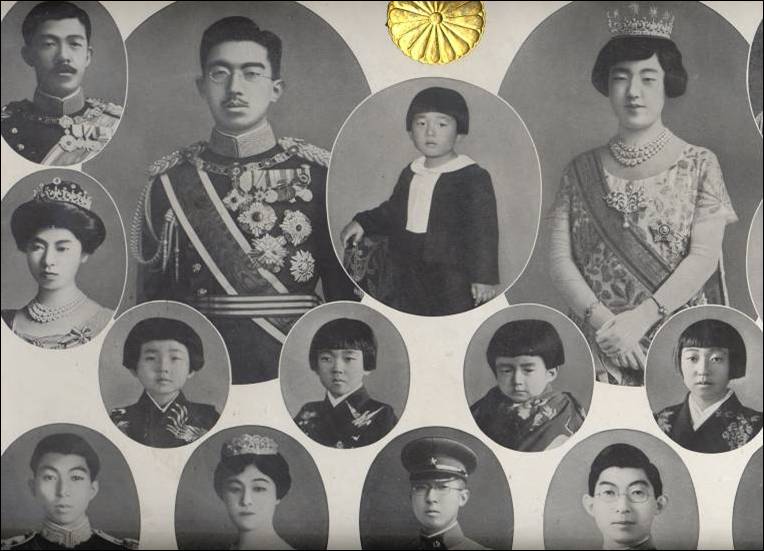
It was also said that looking at the Emperor directly in the eyes would result in punishment of blindness, so students were told not to stare at the picture and it was kept behind curtains except on occasions where the school would open them to pay respects to the Imperial Family.
Distribution of the portraits began in 1874 and by 1920 shrines known as 奉安殿 (ほうあんでん) were built in many places to better preserve the portraits and prevent people dying in attempts to protect them from damage.
After Japan’s defeat in WWII, the iconic picture of the Showa Emperor Hirohito (裕仁) and American military general Douglas MacArthur was taken and published in ordinary newspapers. It is not hard to imagine just how shocking it must have been for the Japanese people to see the god they thought so highly of standing at attention next to their American enemy.
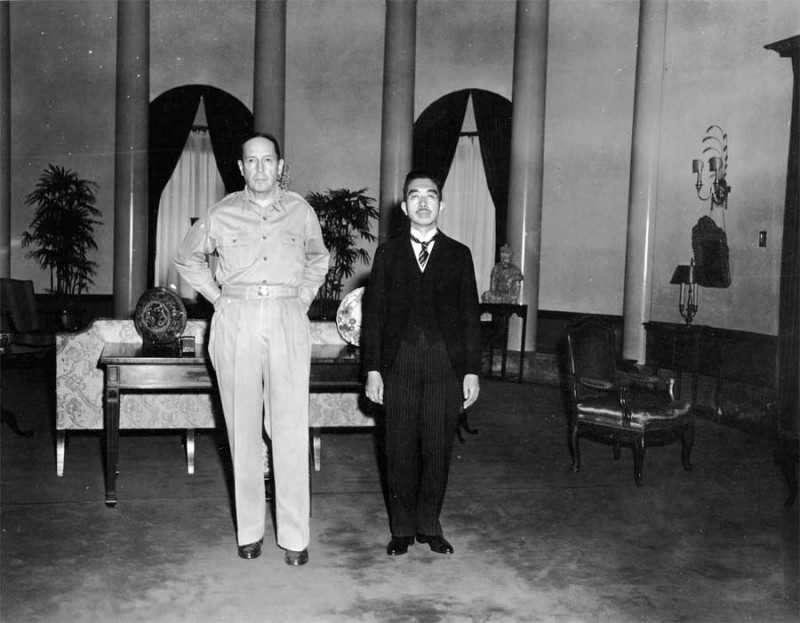
After Japan’s defeat, the Imperial Family Portraits were withdrawn in order to be replaced with a new version. But a new portrait was never re-issued to schools.
In my opinion then, this could mean one of two things. Either this Imperial Family Portrait was taken from a school and brought here for safety, or the portrait was issued to this family directly. All of this before the Imperial Family Portraits were withdrawn in 1946. Judging by the nature of the house, the abundance of expensive-looking items (3 televisions!), a huge collection of photographs of Imperial Family members and the following curious black box containing scrolls and bearing the Imperial mark, I would say there is a good possibility that this place was indeed special and worthy of the nickname ‘Royal House’.
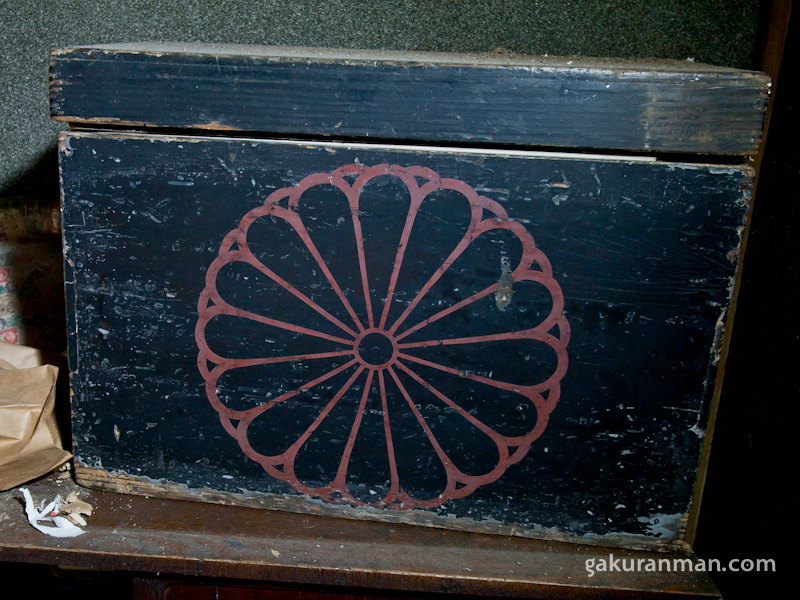
The Former Inhabitant
It’s not clear who did live at this Western-style house. Its distinctive green, orange and white exterior, use of stone and attractive balcony area are very different from the typical Japanese-style house. One of the triangular roofs has collapsed in the picture below.

From the notes inside it’s possible to learn of the family surname and several funeral photographs (characterised by the distinctive black ribbon at the top) suggest that the last owner was an old lady with a shock of white hair. I found her picture in several places around the house, suggesting that she either lived there or was loved very much by the owners. I don’t feel right publishing private photos from the family, but a large painting of the very same lady might just about walk that fine line.

Looking around upstairs, we do learn that the previous owner was a lover of cats. A poster on one wall, cat-related items and one feline in particular named Popo-chan who passed away 1979. The old cat box lovingly adorned with Christmas paper sat next to the owner’s desk and a photo of another cat Happy-chan placed in front of the Buddhist altar. Important members of the family.
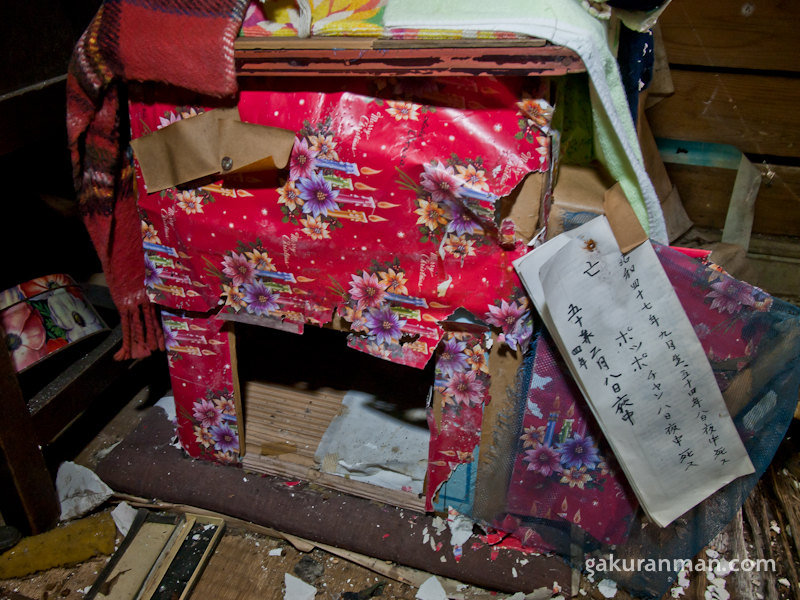
Another mysterious photo found in the hallway of a balding foreign gentleman beaming at the camera. He looks to be sitting in a posh restaurant with a wine glass in front of him. I wonder – did a foreign national live here at some point? Perhaps he is somebody notable the occupant once met and left a great impression?
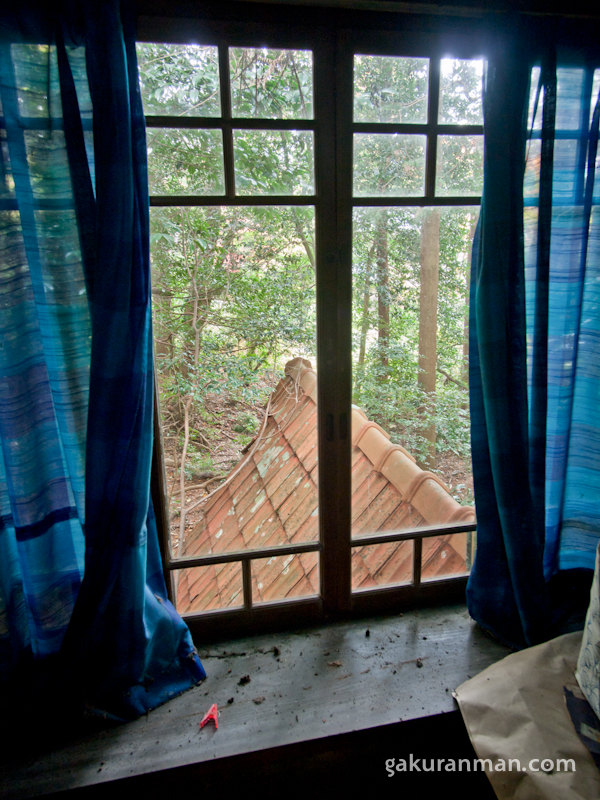
A locked door at the end of the hallway. No way to enter without the proper key for the deadlock. I suppose it’s a bathroom or storage closet, judging by the small size and tiny windows leading outside, but it will remain a mystery for now.
Back downstairs I find a doll with a broken neck. One of many specimens dotted around the house. The painting in the background again suggests a life of luxury. One must wonder where the family went and why all these items remain to slowly decompose..?
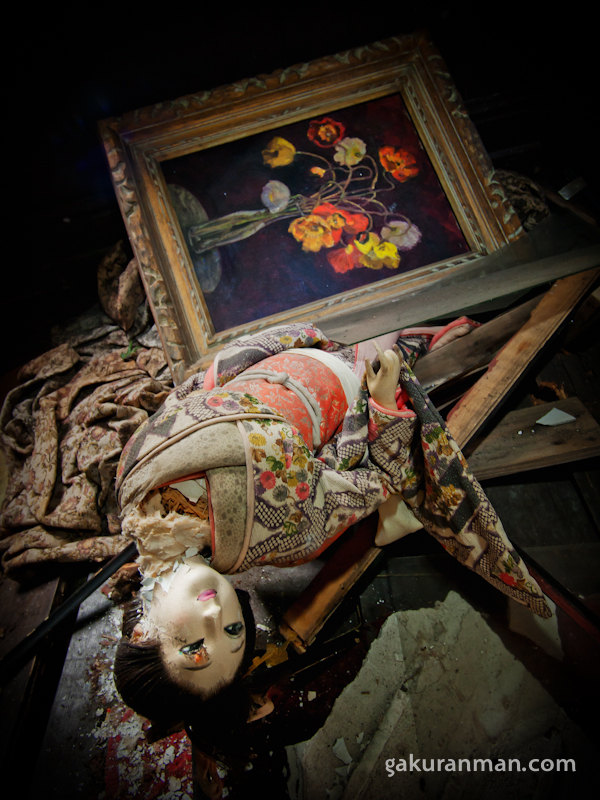
Time is ticking on and I’ve got other haikyo to visit on this day. I circle the building one last time, taking in the interesting exterior. The surrounding trees have caused considerable damage through falling on the house. I imagine it would only take one well-placed trunk to smash in the centre and this piece of history would be levelled.
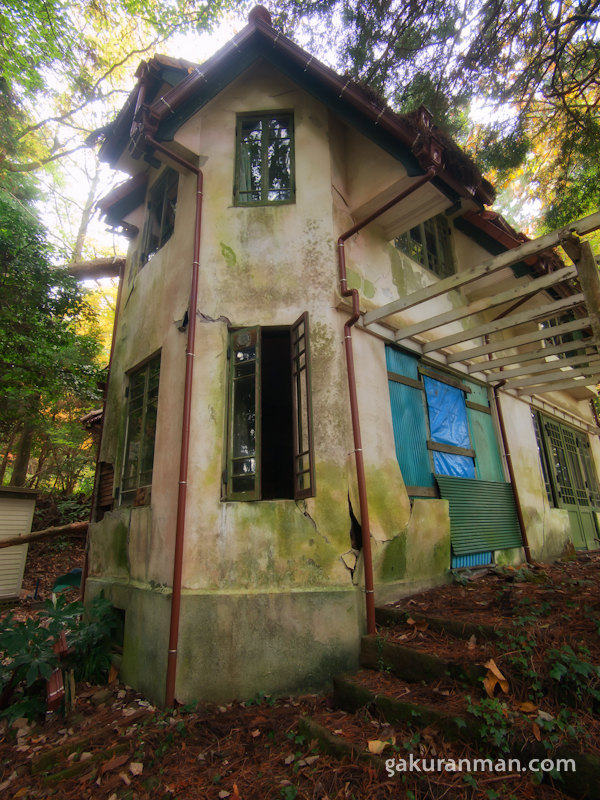
I don’t feel like I’ve even begun to uncover all the secrets of the Royal House haikyo. Hundreds of postcards and letters unread for dozens of years. Hidden items that have sunk beneath the splintering floorboards and a quiet kitchen area with plates and bowls still neatly stacked up. Who did live here and what was their connection to the Imperial Family? Are these items historically valuable? Why is the house exterior Western-style? The mystery still remains to be solved, but perhaps in time it will unravel further. Until then.
**********
**Note** I’ve done my best to protect the privacy of the people who lived here and the location as there is a controversy about publishing these pictures due to the perceived link to the Imperial Family. Previously published pictures of this haikyo have had the portraits blurred out by the author and to the best of my knowledge this is the first time on either the Japanese or English side of the internet that a portrait has been shown without a mosaic. All the pictures I have included are either artist’s impressions, tourist postcards or previously published Imperial portraits, which is as much as I feel happy about posting right now. I would welcome thoughts on the privacy issue and historical implications of posting pictures of the Emperor and Imperial Family. Thanks.









So sad, so beautiful, so much love, loss and time. thank you for showing me. I appreciate that people want history to become museum pieces and certainly preserving objects is very valuable but expensive and the family may not wish it so. Life is transient and so to are the objects that surround our lives.
I live out in the country side in Japan. In my area there are well over 100 such abandoned buildings. In fact, right throughout rural Japan such sites are common. Most of them are full of stuff in various states of decay. Some of the buildings are built in the old Meiji style, a lot are thatched, some are a little more modern. There is nothing at all unusual in your find. I’ve managed to talk to some people about these buildings. In most cases the owner has died and the property is passed on to off spring who are not interested in maintaining the house for a variety of different reasons. Reselling, especially in the country side, is virtually impossible. To have a house demolished costs a surprising small fortune. Families have been set up else where. Off spring moved away from the country side for better opportunities in the city..etc. But be assured, the houses are not forgotten as such. The land is still registered and owned, even if that owner lives in an apartment in Tokyo or some other city.
Be aware that what you did is called trespassing and if the owner were to lay a complaint, you would be prosecuted. The objects contained inside belong to someone.
Anything you remove from the house results in something called theft, which is also treated rather harshly here in Japan. The photo you found of the emperor and his family is not an uncommon one. It is of the same sentiment that finds portraits of the King in British homes 60 or 70 years ago, or of Hitler in German homes..etc.
Japanese put great stock in the respect of privacy. Most of these places are left alone on purpose. It is the owners business. If you mentioned to a museum or local authorities that you explore a lot of these places, you could end up with a slap on the wrist for your troubles.
I understand your fascination with places like this. ME TOO. Some advice, don’t go putting photos of this stuff up on the net, well at least on Japanese domains anyway.
I appreciate your concerns, but the house is abandoned and on the verge of collapse with a wall missing and most of the first floor damaged. The place is wide open and walk-in and exists in a residential area. If people cared enough about the place it would be secured up and looked after, even if the owner lived far away.
I had the same worries as yourself when beginning this hobby, but you begin to get a feel for things when you visit lots of ruins. Most of these places are forgotten and eventually succumb to natural decay or demolition. It’s a great shame that memories are lost in this way and there is also great beauty to be found in ruination. Trespassing itself is also a grey area; I take care when exploring these sort of buildings as you would when visiting anybody’s residence. This particular house captured my attention more than usual due to its unusual background and the people connected to it, driving me to try and find out what happened to everyone. I would like nothing more to answer the questions and hopefully preserve the items in some way.
You might be interested in this post I wrote on haikyo safety:
http://gakuran.com/the-hazards-of-haikyo-and-urban-exploration/
これはあの廃墟サイトで有名になった写真ですね・・・哀しくも美しい写真・・・
コメントありがとうございます。そうです、あの建物。まだ謎が解けてない状態ですけど、近づいている気がします・・・
うわっこれあの建物じゃないか…なぜ外国の人が???それにしても写真が美しいですね
うわっこれあの建物じゃないか…なぜ外国の人が???それにしても写真が美しいですね
Maybe the person who lived there went off to war and did not return. Or possibly if the elderly woman lived there, a walk , a fall and again unable to return.
How fortunate you are to have found this magical place.
This is great Mike, setting a new par for haikyo reporting with the strong historical background you provide- very interesting. Just when I thought there was nothing left to explore, too. I’ll have to roll up my sleeves and dive back into all those Japanese websites again.
Thanks. Glad to offer up some inspiration!
If you are really serious about respecting and preserving the past, you should remove those photos from the Internet and contact some local authorities about this find. Those photos should be salvaged and put in a museum. It’s also possible this lady still has descendents who would treasure these mementos.
You can be sure there are already a number of people trying to find this house to take whatever they can out of it.
When you show some decaying factory, it’s a hobby. When you show this, it’s something else altogether. You have to take some action or all this will be lost. I don’t think you can just be a spectator here.
Thanks for the comment Tetra. What is extremely interesting to me is that all the comments about contacting museums and properly preserving artifacts are coming from English speakers on this website. I’m also reading a number of Japanese websites talking about these pictures and not one single person has mentioned the need to report anything. Very interesting.
I have never been to Japan and I don’t know if I’ll ever be able to afford the trip, but I have been studying Japanese culture and art. I practice sumi-e and calligraphy. I’m also studying Japanese. All this has given me an appreciation of Japanese traditions.
It just doesn’t seem right to see all those artifacts decaying like this. It looks like a disaster movie scene after a nuclear war, when all the people have disappeared but all that’s left are their possessions. It’s possible the Japanese think it would be bad luck for them to take those things, as if they were robbing graves.
I really don’t mean to criticize you. Your photos are extraordinary.
No no, it’s quite alright :). I’m glad you feel able to speak freely; I wouldn’t have it any other way. The problem is that my actions would have a direct affect on the haikyo community in Japan. If many people on the Japanese side were calling for proper preservation I wouldn’t feel worried, but since nobody is, part of me wonders what right I have to go imposing my values onto the community and culture.
Put simply, I’m torn. The ruins fanatic inside me wants this place to stay like it is for many more explorers to enjoy, and the reasonable guy inside me wants to see the items properly cared for. As it stands I’m stuck for what action to take…
Coincidence perhaps, but funnily enough, now we’re finally starting to see some opinions from Japanese speakers on 2ch suggesting the place be reported to protect the stuff.
I’m glad you are getting some responses from Japanese speakers. I realize this is a hobby and not an archeological expedition, but there are some things here really worth salvaging because of their historical value. Sometimes, a gaijin notices the importance of what a native just takes for granted.
All I can say is keep taking as many photos as possible. You are starting to have the makings of a book and a photo show, though I don’t know if a Japanese gallery would be interested!
なにこれこわい
良い写真!とてもノスタルジー!
ありがとう!
It’s admirable that you’re so respectful of haikyo and their previous inhabitants. Many urban explorers for reasons beyond me decide to take souvenirs, but I would feel… I don’t know, guilty, like I was grave robbing. This really is an amazing find. I totally understand that trying to figure out what to do with this location would be hard, but given some of the objects in the house, I can’t help but think that this would best be shared with a museum. Even if a museum in the end can’t do anything, you’d be able to say that you tried. At the same time, I also understand that you’d want to keep the grounds the way the owners intended and not allow others to forcibly remove pieces of history. With most normal haikyo locations I would agree, but the potential historical significance here is too much, in my opinion, to let go.
Regardless, thank you for sharing this. The shots are amazing. I really wish I could explore Japan – the ruins I’ve seen explored by others look absolutely incredible – but given my wallet and the potential culture shock, I think I’ll stick to Canadian ghost towns for now. :P I’m relatively new to the hobby though, so If I do decide to do some international exploring one day, would it be alright if I hit you up for some tips?
Hey Iggy. Cheers for the comment. Feel free to contact me if you ever come to Japan and I’ll help you out with some books on the subject and whatnot.
where is this?
I have seen .Fukuoka?
While it is really awesome and awe inspiring to find such a house walk through it, why not call a museum about it? Isn’t part of your duty in going to these places to preserve history? Sure it will suck that someone else in a couple of years won’t be able to re-find this house, but by the look of that house it won’t take long at all for the forest to reclaim it. If those photos of the Imperial Family are as sacred as you say, then why are you not doing more to make sure they are preserved?
It’s a delicate matter. Even calling a museum and explaining the situation isn’t guaranteed to help. There would be all sorts of bureaucratic tape to get through, not to mention the trouble of trying to contact relatives of the original owner and deciding the circumstances under which it would be okay to forcibly remove items from the property for preservation purposes. There is also value in leaving things as they are to let nature take its course, the will of the original owner and family heirlooms that they may not want moved. I don’t feel it’s my right to make a decision on behalf of other people, but I do sympathise with your concerns. I’m still thinking about what best to do.
Y’know, you could find out the general address around there and go to the local city registration office. It’s pretty cheap to find out who the property is presently registered as belonging to. My cellphone has that mapping function and it’s old.
Your post is on metafilter!
http://www.metafilter.com/97866/A-House-Worthy-of-the-Name
Thanks for letting me know :)
Let me know what you find out about the history of the vases in the underground shrine and stuff! I haven’t come across any information about the builder of this house yet :(.
Another great haikyo post. Really enjoying these.
chris
Cheers Chris :p
Cheers Chris :p
It’s an awkward situation. Part of me does think some of these items should be taken out and preserved in a museum, but by doing so the very atmosphere and mystique of the place will vanish.
It’s an awkward situation. Part of me does think some of these items should be taken out and preserved in a museum, but by doing so the very atmosphere and mystique of the place will vanish.
This strikes a good balance between representing the beauty of the Haikyo and respecting the legacy of those who lived there. We should always try to do this at Haikyos and not just because there may be some link to the royal family.
I think you are definitely right to keep the details to yourself. It is something really special to have such an intimate look into the life of the house and people who lived there. It shouldn’t be open to scavengers and vandals.
Thanks. I certainly hope it’s viewed that way. Many Urban Explorers have a bad reputation and are often mistakenly viewed are nothing more than thieves or vandals. And although there are no official rules on the hobby (I don’t think there ever could be), I find it good practice to keep locations secret and only share information with trusted friends. Most if not all the places I have visited in the past have ended up being wrecked or locked up through too much exposure on the internet.
Great post! I just discovered your site and have spent the morning reading all your adventures with the ruins :) So thank you for a great morning filled with beautiful photos and fascinating stories!
Thanks for reading and the kind words Cin :).
What a great read, where can I find these haikyo? They look fascinating and give more about Japanese history than any shrine. Certainly not a usual tourist must see too, are they difficult to get too without your own transport?
A book to get you started is called Nippon no Haikyo. I recommend you check it out if you’re interesting in visiting some abandoned places :). You likely will need a car for most adventures though!
As usual a beautiful and thought-provoking post. Reading it I can’t help but think you are actually providing an important service/purpose, documenting historical artefacts and moments in time that may otherwise disappear. You do it with such respect, a near reverence, that I can’ imagine anyone would fault you.
Is there any way of letting the local historical society know about the existence of this place and what it contains? They would possibly be able to look after anything important inside it.
Thanks for the comment. Letting the historical society know might be a good idea to save any artifacts, but the downside is that this place would cease to exist among the haikyo community. I can’t imagine I would be popular if that happened… Hmm, what to do..?
A great point. I guess only you can decide on where you draw that line. Do you keep something ‘within the community’ amongst people who in the main seem to appreciate and respect these places, or do you try to help other preserve it, but then perhaps see these amazing things packed away, not to be seen by anyone?
I am just glad that we get to share via the blog.
It’s not like great concrete building, sitting on an open lot, that would take decades to fall apart. You said yourself, it won’t be long before the forest claims this house from the haikyo community, and your photographs will be all that remains. Therefore the time to snatch the salvageable items for future generations to study, is now.
This is fascinating! It’s great you have such a respect for these places. Hopefully someone who knows something or can help save some of these things will contact you.
I enjoy reading your posts. Thank you!
Cheers for the kind words Julie :).
Thanks for the comment Louise!
I read your new post from the Shinkansen as I passed Nagoya. You are fast, very fast, I didn’t expect to see this post so early with such an excellent write-up and valuable information. This haikyo is truly a historical gem, and deserves not to be forgotten. I hope that we’ll learn more about it later though: the presence of this white guy along royal relics is kind of odd. Forgive me in advance Mike, I think you’ll find a (very) approximate translation of this post in French soon :)
I look forward to reading it! This place really is fascinating :)
Another mysterious haikyo. In addition you’ve uncovered many new historical information for us! Thanks!
Took me a while to find some good sources, but it was worth it. What a find!